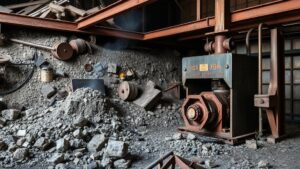How to Interpret L-Rod Crossings When Searching for Subsurface Resources
How to Interpret L-Rod Crossings When Searching for Subsurface Resources
The L-Rod, often utilized in dowsing practices, is a tool traditionally associated with locating underground resources such as water, minerals, and fossils. Understanding how to interpret L-Rod crossings is crucial for practitioners aiming to enhance the efficacy of their searches. This article provides a comprehensive guide on this topic, exploring the mechanics of the L-Rod, the significance of its movements, and practical applications in the field.
Understanding the L-Rod
The L-Rod is commonly fashioned from a conductive metal, typically copper or brass, bent into an L shape. Its design allows it to be easily manipulated, making it sensitive to subtle environmental changes indicating the presence of subsurface materials. When held properly, the L-Rod is believed to rotate or cross in response to unseen energies, which some practitioners interpret as signals of underground resources.
The Mechanics of L-Rod Crossings
Interpreting L-Rod crossings hinges on understanding its response during operational use. Practitioners typically hold the rods parallel to each other, with an intended target or area of interest ahead. As they approach a resource, a crossing occurs when the rods move inwards toward each other or cross over one another. This reaction is often seen as an indication that the sought resource lies below the surface.
Factors Influencing L-Rod Responses
Several factors can affect L-Rod behavior, including:
- Geological composition: Different materials can generate various energy signatures; for example, the presence of minerals like quartz may enhance L-Rod reactions.
- Water sources: Dowsers frequently report more pronounced L-Rod activity near aquifers, where the movement of water enhances energetic fields.
- Environmental factors: Electromagnetic interference from nearby power lines or devices may produce erratic responses in the L-Rod.
Interpreting Crossings in Context
When L-Rod crossings occur, interpreting their significance requires context. Practitioners must consider surrounding conditions, the type of resource being sought, and any noticeable patterns emerging from the crossings.
Types of Crossings
Understanding the nature of the crossings can provide invaluable insights:
- Single Crossing: Often interpreted as a strong signal indicating a likely resource presence.
- Multiple Crossings: Repeated crossings may suggest proximity to a substantial deposit or multiple sources.
- Resistance to Cross: When the rods remain apart, it may indicate the absence of resources or interference from external sources.
Case Studies and Practical Applications
Real-world applications of L-Rod usage highlight the relevance of understanding their crossings. In 2021, a team of practitioners employed L-Rods in a remote area of Texas, focusing on groundwater exploration. Using proper techniques, they identified several locations where the rods crossed, correlating with groundwater surveys confirming aquifer presence. This validated the potential reliability of L-Rod methods in practical exploration efforts.
Actionable Takeaways
For practitioners looking to utilize L-Rod crossings in their search for subsurface resources, consider the following actionable steps:
- Practice handling the L-Rod to become familiar with its movement dynamics.
- Monitor environmental conditions that may influence readings.
- Document findings carefully to track patterns over time.
- Consider combining L-Rod observations with geological surveys for more accurate assessments.
To wrap up, interpreting L-Rod crossings can enhance the search for subsurface resources significantly. By understanding both the mechanics of the L-Rod and the context in which crossings occur, practitioners can refine their searches and potentially improve their success rates in resource discovery.



